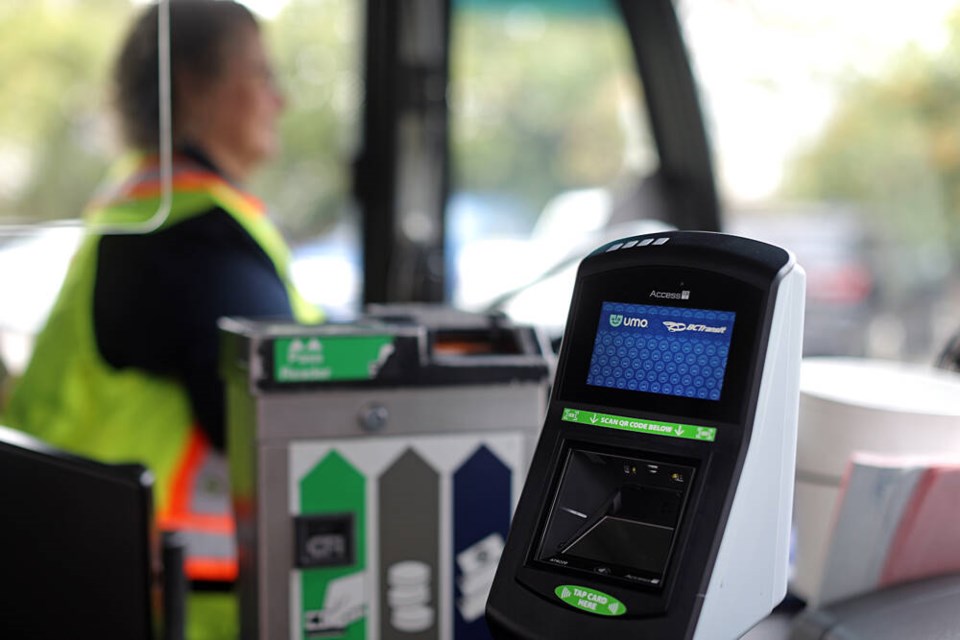B.C. Transit in Greater Victoria is switching its fare payment system to one that involves the tapping of a card or the scanning of a QR code on a phone screen. It replaces card sliding and paper tickets.
Here are some things I discovered while signing up for the new Umo system and then using it to go riding.
For the Umo phone app, I was hoping that I could set up my password and registration details using the keyboard and big screen of my desktop computer. But that wasn’t an option at the ca.umopass.com website. So I grudgingly pecked away on the phone.
You link the app to a credit card and select the amount of money you want to funnel into Umo. (You can also buy 30-day passes.)
I wanted to auto-load money into my account, so that I wouldn’t have to repeatedly log in to top up. But I couldn’t find instructions on the bctransit.com/umo website. And I couldn’t find a way on the phone app.
After clicking all the buttons at ca.umopass.com, I discovered auto-load tucked away under My Wallet. This message popped up: “Automatically load the following amount when my balance falls below $5.00.” There is no option to change the $5. You can top up with an amount from $5 to $250.
In advance of my first ride, I noticed this warning: “Payment cards and passes in Wallet will not work automatically while ‘Umo’ is in use.” This turned out to be true on my iPhone. I couldn’t make a payment with ApplePay while Umo was running. You have to quit the Umo app, not just clear it from your screen.
For my first ride, I pulled out my phone, launched the Umo app and selected “Validation Code,” which took me to a screen with a flashing QR code. When the bus arrived, I boarded and put the screen side of my phone in front of a fare scanner. And nothing happened. The bus driver said, “Hold it a little lower.” I did and I got a check mark on the fare-machine screen and a quiet beep.
The next person who boarded also used the phone app, and it worked immediately. But every other rider after that used the old methods for paying their fare.
A note on the app’s wording. A couple of people have mentioned to me that “Validation Code” is confusing. Instead, it should say something like “Tap before boarding” or “Ticket.”
I also opted to get a fare card, which you can load with cash through a vendor, phoning B.C. Transit, or registering the card on the Umo website and linking a credit card to your account.
The card and the app must operate separately. If you link a card to an account that is also linked to an app, the card will be disabled.
I got the card as a backup and in case someone travelling with me doesn’t have a card or the app.
My usual ticket vendor said they didn’t have the new fare cards and were not sure when they’d arrive. So I checked the vendors list on B.C. transit’s website — bctransit.com/victoria/fares/where-to-buy. Not all vendors are set up for Umo yet. On the list, look for vendors with the Umo logo.
Picking up the card took longer than I expected. I asked for $20 to be loaded, but the computer for loading was in use for something else. After 10 minutes and several apologies from the clerk, the task was done.
The clerk told me that they’d given out about 1,000 cards since B.C. Transit announced last week that Umo was live. The majority picked up a card without loading cash at the store. As I was leaving, the clerk asked me: Do you know if this will work in Vancouver?
The answer is no, unfortunately. It would be nice if it did. But there’s no indication of that on the horizon.
So, Umo card or Umo app?
The Umo card is easier to use. Pull it out from your pocket and tap.
The Umo app: pull out phone, turn it on, launch app, make QR code appear on screen, show code to scanner.
I’m using the app for now because it provides next-bus times for stops as well as trip planning. In my brief testing, the next-bus function works well.
I might change my mind after further weighing the fact that the app tracks my every transit move, while the card allows me to be anonymous if I don’t register it.
• A couple of readers have pointed out that under the new system, we'll be losing the 10-ticket-sheet discount. They're still available, $22.50 for 10 $2.50 tickets. Slide in two tickets at the fare box to get a day pass for $4.50. If you pay cash, it's $5. B.C. Transit hasn't announced a date yet for when they'll no longer accept paper tickets.
>>> To comment on this article, write a letter to the editor: [email protected]



